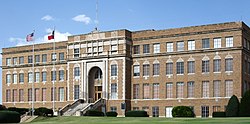Hutchinson County, Texas
| Hutchinson County, Texas | |
|---|---|

The Hutchinson County Courthouse in Stinnett
|
|
 Location in the U.S. state of Texas |
|
 Texas's location in the U.S. |
|
| Founded | 1901 |
| Seat | Stinnett |
| Largest city | Borger |
| Area | |
| • Total | 895 sq mi (2,318 km2) |
| • Land | 887 sq mi (2,297 km2) |
| • Water | 7.5 sq mi (19 km2), 0.8% |
| Population | |
| • (2010) | 22,150 |
| • Density | 25/sq mi (10/km²) |
| Congressional district | 13th |
| Time zone | Central: UTC-6/-5 |
| Website | www |
Hutchinson County is a county in the U.S. state of Texas. As of the 2010 census, its population was 22,150. Its county seat is Stinnett. The county was created in 1876 but not organized until 1901. It is named for Andrew Hutchinson, an early Texas attorney.
Hutchinson County comprises the Borger, TX Micropolitan Statistical Area, which is also included in the Amarillo-Borger, TX Combined Statistical Area. It is located in the northern portion of the Texas Panhandle. The history of Hutchinson County is accented in downtown Borger in the Hutchinson County Historical Museum, also known as Boomtown Revisited.
Artifacts of the Antelope Creek Indian culture abound along the Canadian valley in Hutchinson County. Archaeologists have found 1,300 acres (5.3 km2) of Alibates flint in the area that was used as a quarry for shaping flint tools. Nomadic Plains Apache also camped in this area as did Comanche, Arapaho, Kiowa, and Cheyenne.
Bent, St. Vrain and Company established a trading post in this area to tap into Indian trading. Known as Fort Adobe, it was blown up by traders three years later due to Indian depredations. The ruins became known as Adobe Walls.
The First Battle of Adobe Walls took place in 1864 when General James H. Carleton sent Col. Christopher (Kit) Carson into the area to avenge for repeated Indian attacks. Carson and several hundred cavalry officers were greatly outnumbered by Kiowa and Comanche and forced to retreat. The Second Battle of Adobe Walls took place in 1874. A group of buffalo hunters attempted a revitalization of Fort Adobe. The Comanches, Cheyenne, Arapaho and Kiowa saw the fort and the decimation of the buffalo herd as a threat to their existence. Comanche medicine man Isa-tai prophesized a victory and immunity to the white man’s bullets in battle. Quanah Parker lead several hundred in a raid on the fort. The buffalo hunters were able to force the Indians into retreat.
...
Wikipedia
